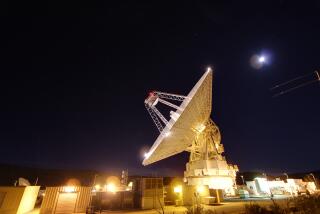Marking Time in Space
- Share via
The political snags that continue to stall the space station accurately reflect a gnawing indecision about whether the project should be pursued. In his State of the Union address more than four years ago, President Reagan endorsed the space agency’s plan for an $8-billion permanent space station in orbit by 1992. The cost is now $16 billion, it will not fly until 1996 at the earliest, and no one is yet sure why it is needed.
The space agency continues to insist, as it has done from the outset, that a permanently manned station with full laboratory facilities for scientists and manufacturing capabilities for industry is the next logical goal in America’s space program. The Soviets have been operating their Mir space station almost continuously for several years now, and a reduced American commitment to a space station would abandon the field to our competition. Even the Europeans are planning to loft their own space station. Can the United States simply walk away?
It need not. Despite the unwavering support of the National Aeronautics and Space Administration for its space-station project, there are many people in Congress, equally well informed, who think that there are other ways to maintain this country’s space program without building a gold-plated space station whose purpose remains unclear. While the various appropriating committees in Congress alternately remove and restore space-station funding, other planners are thinking about a mini-space station--smaller and cheaper and less ambitious. Not surprisingly, NASA would like to have the mini-space station in addition to the big space station. Its congressional supporters would like to have one instead of the other.
Reflecting continuing uncertainty about the value of the space station in a time of budget deficits, the Senate Appropriations Committee voted recently to slash space-station spending for next year from $967 million to $200 million. Let the next Administration decide what to do, the committee seemed to be saying.
But space-station supporters on the committee then tried to save the project by transferring $200 million from the Air Force and $400 million from the Pentagon to NASA--a move that the full Senate will have to grapple with when it votes on the Defense Department budget later this summer. James C. Miller III, director of the White House Office of Management and Budget, has already indicated that efforts to pay for the space station out of the Pentagon budget might provoke a presidential veto--an odd twist for a President who endorsed the space station in the first place.
In this morass the best thing to do is wait. A new Administration with new priorities and a new political mandate will take office in January. It is unrealistic to think that the space station will be part of this fall’s political debate, but between now and then there may be some sorting out and a clearer understanding of what should be done. The sharp political disagreement that currently holds sway indicates a lack of national consensus about how to proceed. Under the circumstances, it would be foolish to press ahead.
More to Read
Sign up for Essential California
The most important California stories and recommendations in your inbox every morning.
You may occasionally receive promotional content from the Los Angeles Times.










